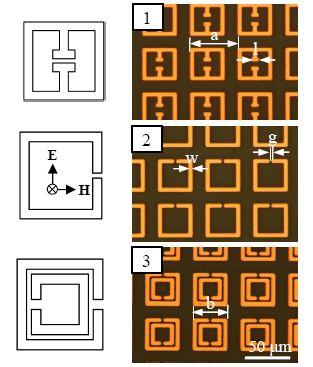Source: Tech-On!
Boston University announced that it is currently prototyping an ¡°invisibility cloak¡± that functions against electromagnetic waves with a frequency of about 1THz (THz wave, wavelength: approximately 300?m) at IEDM 2008.
The invisibility cloak, in this case, means a cylindrical medium that has the following two characteristics. First, its reflection and absorption are small enough. Second, it diverts electromagnetic waves so that the content inside the cylinder cannot be seen from the outside. This medium, whose effective permittivity and permeability can be set at any value, is called ¡°metamaterial.¡±

Examples of SRR shapes
The invisibility cloak is intended for use as a countermeasure against THz wave-based clairvoyance technology.
¡°THz waves can be used to see through clothes,¡± said Hu ¡°Tiger¡± Tao, Department of Mechanical Engineering at Boston University. ¡°So, by using those waves, people can tell, for example, if you got a weapon. But if you have an invisibility cloak that works against THz waves, you can prevent them from knowing your possession of the weapon.¡±
To put it another way, this is an attempt to countervail a THz technology with another THz technology.

Transmission of electromagnetic waves in a simulation
In 2006, Duke University developed an invisibility cloak for microwaves. It changed the shape of a metal pattern called SRR (split-ring resonator) little by little and realized desired permittivity and permeability.
In theory, Duke University¡¯s cloak can be upgraded for THz waves by drastically reducing the scale of the SRR in accordance with their wavelength. However, the size of the SRR, which is square shaped, is several millimeters on a side for microwaves while that for THz waves must be several tens of micrometers on a side. In addition to the small size, it has been a problem to radially accumulate SRRs to form a cylindrical shape.
To solve these problems, Boston University employed the following method. First, a 20?m-thick polyimide film is formed on a Si substrate, and gold (Au) and titanium (Ti) formed SRRs on it. Then, the polyimide film is removed and shaped into a cylinder.
The SRRs on the film are arranged at a pitch of 50?m. The invisibility cloak can be made by forming many films while gradually changing the size of the SRR and laminating them in a concentric fashion.
However, Boston University has just confirmed that it is possible to form each layer and obtain target values of permittivity and permeability. A computer simulation proved that the cloak can be realized by using about 50 layers.

